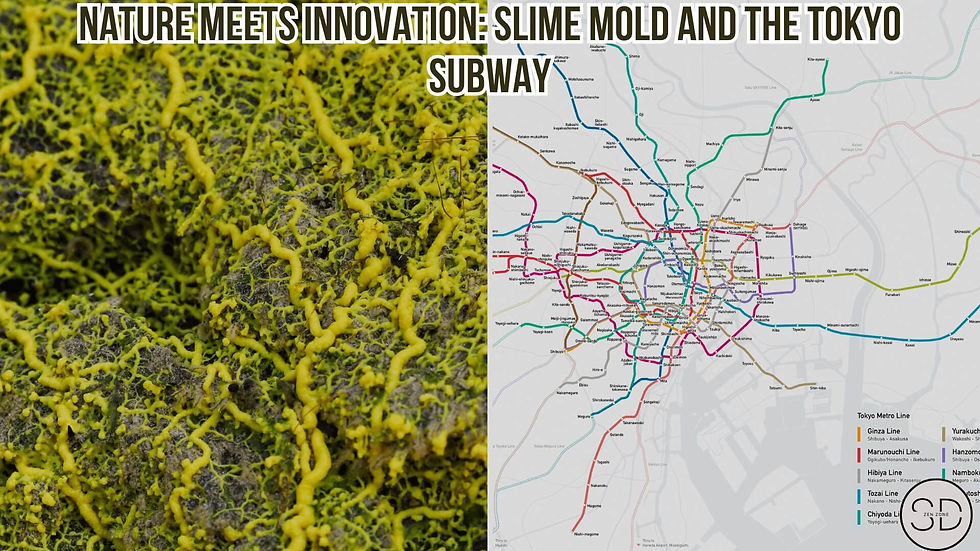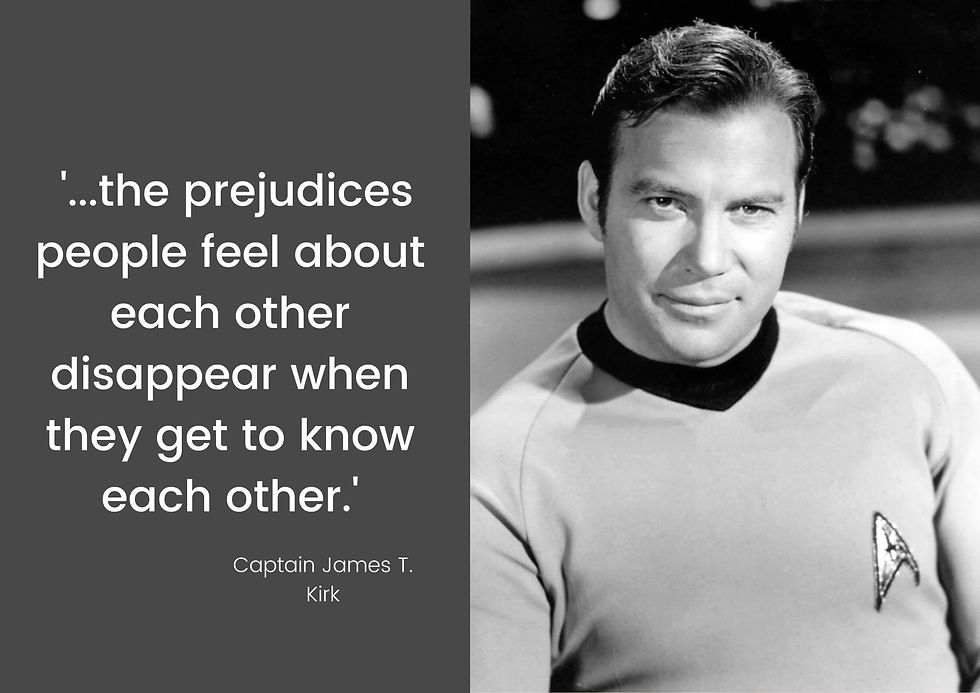“Biomimicry is basically taking a design challenge and then finding an ecosystem that’s already solved that challenge, and literally trying to emulate what you learn.”— Janine Benyus

Table Of Content
Introduction: Unveiling Nature’s Genius in Urban Design.
Section 1. Slime Mold and Tokyo's Subway System: A Biomimicry Breakthrough.
Section 2. Adaptive Network Design: The Biomimicry Approach.
Section 3. Personal and Professional Growth: Insights from Biomimicry.
Section 4. Conclusion: Embracing Biomimicry for Future Innovations.
Introduction: Unveiling Nature’s Genius in Urban Design
In the vast expanse of space and the complexities of the universe, Captain James T. Kirk of 'Star Trek' once observed.

This profound insight resonates beyond interstellar diplomacy, shedding light on our underestimations of nature's intelligence and creativity. In the realm of biomimicry, nature's designs offer ingenious solutions, often surpassing human-made systems in efficiency and sustainability.
Biomimicry, deriving from the Greek words bios (life) and mimesis (imitation), represents a pinnacle of innovation. It encourages a transformation to a sustainable future by asking how nature solves complex problems. From Leonardo da Vinci to modern scientists like Janine Benyus, biomimicry has inspired remarkable innovations, such as energy-efficient designs and self-cleaning surfaces, proving its worth in modern problem-solving.

Our journey through this concept leads us to an unexpected teacher: Slime Mold. This simple, brainless organism, often overlooked, has provided insights into efficient network design, notably demonstrated in a study that recreated Tokyo's subway system.
This article explores how this humble mold challenges our assumptions and guides us in thinking outside the box, applying nature’s genius to both personal and professional growth.
Section 1. Slime Mold and Tokyo's Subway System: A Biomimicry Breakthrough

In the words of Merlin Sheldrake, which poignantly set the stage for our exploration:
"A slime-mold enthusiast told me about a test he had performed. He frequently got lost in IKEA stores and would spend many minutes trying to find the exit. He decided to challenge his slime molds with the same problem and built a maze based on the floor plan of his local IKEA. Sure enough, without any signs or staff to direct them, the slime molds soon found the shortest path to the exit. ‘You see,’ he said with a laugh, ‘they’re cleverer than me.’"
1.1 The Unique Biology of Slime Molds: Nature's Network Architects
Slime molds, a fascinating group of organisms in the Protista kingdom, blur the line between animal and fungi characteristics. These adaptable life forms excel in environments rich in moisture and organic matter, relying on a saprophytic diet to thrive. The most captivating aspect of their biology is the plasmodium stage, a multinucleate mass that can spread across large areas, showcasing their unique survival and adaptation strategies.
1.2 Reimagining Tokyo's Subway: Lessons from Slime Mold
In a pioneering 2010 study, researchers harnessed the unexpected genius of Physarum polycephalum, a species of slime mold, to revolutionize urban planning concepts:
Experiment Setup: A large dish represented the Tokyo area, with oat flakes placed at points corresponding to major Tokyo cities.
Slime Mold's Behavior: The slime mold began to form a network of plasmodia, extending towards the oat flakes.
Remarkable Outcome: The network created by the slime mold astonishingly resembled Tokyo's actual subway layout.
Innovative Implications: This experiment proved the slime mold’s uncanny ability to address complex spatial challenges, challenging conventional urban planning methods and paving the way for bio-inspired network design.
This not only highlights the remarkable capabilities of slime molds but also underscores the potential of nature-inspired approaches in modern urban planning. It serves as a vivid example of how seemingly simple organisms can offer groundbreaking solutions to complex human challenges.
1.3 From Skepticism to Acceptance: A New Era in Urban Planning
Initially met with skepticism, the idea of using slime mold in urban planning gained acceptance as its efficiency in creating optimized networks became evident. This shift marked a turning point in embracing biologically inspired solutions in various disciplines.
Section 2. Adaptive Network Design: The Biomimicry Approach

Biologically inspired adaptive network design draws from nature's evolutionary strategies to address complex human network challenges:
Efficiency and Robustness: Mirroring biological networks like neural and vascular systems, these designs are both efficient and resilient, capable of handling high volumes and recovering quickly from disruptions.
Adaptability and Decentralized Control: These networks adapt to environmental changes without centralized control, ensuring scalability and effective management.
Trade-off Optimization: Balancing cost, efficiency, and fault tolerance, they reflect nature’s ability to navigate complex optimization problems.
Applications and Mathematical Modeling: Applied in urban planning and computer networking, this concept is guided by biologically inspired mathematical models.
2.1. Innovative Solutions Inspired by Nature: Beyond Slime Mold
The concept of biomimicry extends beyond theoretical principles, manifesting in groundbreaking innovations that have revolutionized various industries. By emulating nature's designs, engineers and scientists have developed solutions that are not only effective but also sustainable. Here are some notable examples where nature's ingenuity has been a source of inspiration:
Bullet Trains & Kingfisher Birds: In the quest for speed and efficiency, Japan's bullet trains faced a significant challenge: noise. Engineers found an unlikely muse in the Kingfisher bird, known for its smooth, splashless dive into water. The train's front design, modeled after the bird's beak, resulted in a quieter, faster, and more efficient train, effectively reducing the sonic boom effect when the train exits tunnels.
Wind Turbines & Humpback Whales: The majestic Humpback whale, with its unique fin design featuring tubercles or bumps, inspired a significant improvement in wind turbine blade design. This biomimetic adaptation allows for better aerodynamics and efficiency, reducing drag and increasing lift, thus enhancing the turbines' energy output.
Ant Colony Optimization: The foraging behavior of ants, particularly their pheromone trail system that leads to the most efficient routes to food sources, has been instrumental in developing algorithms for network pathfinding. This approach is now widely used in logistics and routing software, optimizing paths and reducing operational costs.
Termite Mounds & Building Ventilation: The intricate ventilation system of African termite mounds, maintaining a constant internal temperature despite external heat, has inspired architects to design energy-efficient buildings. These structures mimic the natural air circulation principles found in termite mounds, leading to a significant reduction in artificial cooling needs.
These examples underscore the limitless potential of looking to nature for inspiration. As we continue to face various engineering and design challenges, turning to the natural world for solutions can lead to more sustainable and effective innovations.
Section 3. Personal and Professional Growth: Insights from Biomimicry

The remarkable strategies of slime mold in network optimization offer intriguing lessons for personal and professional growth, aligning with the ethos of SD Zen Zone:
Efficient Adaptability: Mirroring slime molds, we can adapt and connect disparate elements in our careers with agility and efficiency. Embracing change, like learning new technologies or skills, isn't just necessary; it's a path to thrive in a dynamic professional landscape.
Collaborative Decision-Making: The decentralized, yet effective decision-making process of slime molds inspires a collaborative work culture. Involving diverse perspectives leads to innovative solutions, reflecting our site's commitment to holistic professional development.
Resilient Problem-Solving: The resilience of slime molds, capable of rerouting and overcoming obstacles, is a metaphor for our own career resilience. Facing setbacks with a problem-solving mindset echoes our site’s message: challenges are opportunities for growth and innovation.
Predictive Career Planning and Maintenance: Just as predictive modeling in slime mold studies leads to efficient networks, applying these principles to career planning empowers us to anticipate and prepare for industry trends. It's about strategically positioning ourselves for future opportunities.
Understanding this concept's application extends to areas like Predictive Maintenance Systems (PMS) in AI and manufacturing. To delve deeper into how AI is revolutionizing predictive strategies, explore our article “How AI Is Changing the World”.
This study exemplifies 'thinking outside the box,' a core principle at SD Zen Zone. It encourages us to look to nature for ingenious solutions, blending the wisdom of the natural world with cutting-edge professional strategies. In personal and professional development, like in nature, the most adaptive and innovative thrive.
Section 4. Conclusion: Embracing Biomimicry for Future Innovations
In exploring the case of slime mold and its pivotal role in optimizing Tokyo’s subway system, we've journeyed through a remarkable example of nature's genius and the value of interdisciplinary collaboration.
Learning from Nature: The slime mold, a seemingly simple organism, effectively solved a complex spatial problem, underscoring the power and efficiency of natural algorithms. This instance illuminates the broader concept of biomimicry or bioinspired design, where nature's time-tested strategies offer innovative solutions to our complex challenges.
Interdisciplinary Approach: This study wasn't just about biology; it was a fusion of biology, computer science, and urban planning. By transcending traditional disciplinary boundaries, the researchers gained unique insights, demonstrating how combining diverse fields of knowledge can lead to groundbreaking innovations.
As we close this exploration, let us ponder on how these principles can be applied beyond the realm of urban planning. How might the adaptability, resilience, and interdisciplinary thinking demonstrated by the slime mold inspire new approaches in our personal and professional lives?
To continue exploring innovative concepts and growth strategies that transcend conventional boundaries, visit SD Zen Zone. Join us in discovering more thought-provoking ideas and insights that can propel your journey towards personal and professional excellence.
Reference
Biomimicry: How Business Solves Problems by Looking to Nature
Rules for Biologically Inspired Adaptive Network Design - Science
Exploring Biomimicry: History, Examples, Benefits, and ... - Bootcamp
Berkeley BioDesign - The Best of Biomimicry: Here's 7 Brilliant Examples of Nature-Inspired Design
Slime Mould Attacks Simulates Tokyo Rail Network - National Geographic
Brainless Slime Mold Builds a Replica Tokyo Subway - Discover Magazine
Using a 'Virtual Slime Mold' to Design a Subway Network Less Prone to Disruption - Phys.org


Comments